
Isoetes, commonly known as the quillworts, is a genus of lycopod. It is the only living genus in the family Isoetaceae and order Isoetales. There are currently 192 recognized species, with a cosmopolitan distribution mostly in aquatic habitats but with the individual species often scarce to rare. Some botanists split the genus, separating two South American species into the genus Stylites, although molecular data place these species among other species of Isoetes, so that Stylites does not warrant taxonomic recognition. Species virtually identical to modern quillworts have existed since the Jurassic epoch, though the timing of the origin of modern Isoetes is subject to considerable uncertainty.
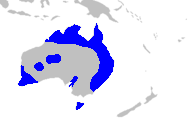
Xanthorrhoea is a genus of about 30 species of flowering plants, in the family Asphodelaceae. They are endemic to Australia and are known by the name Black Boy.

Sphaeropteris cooperi, synonym Cyathea cooperi, also known as lacy tree fern, scaly tree fern, or Cooper's tree fern, is a tree fern native to Australia, in New South Wales and Queensland.

Cape Leeuwin is the most south-westerly mainland point of the Australian continent, in the state of Western Australia.
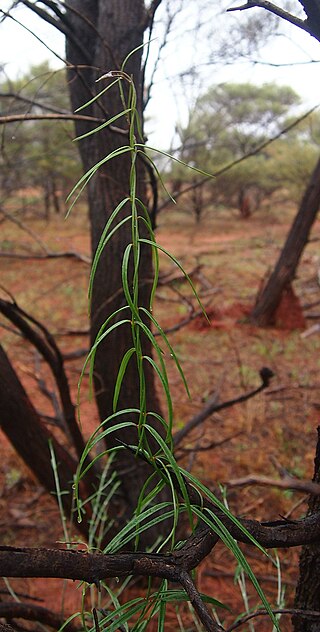
Leichhardtia australis, commonly known as the bush banana, silky pear or green vine is an Australian native plant. It is found in Central Australia and throughout Western Australia. It is a bush tucker food used by Indigenous Australians.

The Avon Wheatbelt is a bioregion in Western Australia. It has an area of 9,517,104 hectares. It is considered part of the larger Southwest Australia savanna ecoregion.

Lobelia dortmanna, Dortmann's cardinalflower or water lobelia, is a species of flowering plant in the bellflower family Campanulaceae. This stoloniferous herbaceous perennial aquatic plant with basal leaf-rosettes and flower stalks grows to 0.7–2 m (2.3–6.6 ft) tall. The flowers are 1–2 cm long, with a five-lobed white to pale pink or pale blue corolla, produced in groups of one to ten on an erect raceme held above the water surface. The fruit is a capsule 5–10 mm long and 3–5 mm wide, containing numerous small seeds.

The knife-footed frog is a species of burrowing frog in the family Hylidae. It is endemic to Australia, where it is found over a wide area in the north of the continent.

Isoetes engelmannii is a species of aquatic plant in the family Isoetaceae. It is referred to by the common names Engelmann's quillwort or Appalachian quillwort, and is the most widely distributed species of its genus in eastern North America. Its range extends from Ontario in the north, south to Florida and west Arkansas and Missouri. It can be found from April to October in temporary pools, bogs, marshes, stream edges, swamps and along wet roadsides.

Posidonia australis, also known as fibre-ball weed or ribbon weed, is a species of seagrass that occurs in the southern waters of Australia. It forms large meadows important to environmental conservation. Balls of decomposing detritus from the foliage are found along nearby shore-lines.

Calamus australis, commonly known as wait-a-while, hairy mary or lawyer cane, is a plant in the palm family Arecaceae which is endemic to the rainforests of north east Queensland, Australia. Like other species in the genus Calamus, this is a climbing plant with a very long and flexible stem. It uses sharp strong hooks on the fronds and tendrils to attach itself to other vegetation, such as taller established trees, thus gaining support that enables it to grow higher towards the canopy. This species is very similar to C. radicalis, with which it coexists, but is smaller in almost all respects.
Isoetes eludens is an aquatic plant in the genus commonly known as quillwort that is native to the Kamiesberg Mountains in Namaqualand, South Africa. So far it is known to grow only in a single !gau (gnamma), a small temporary pool formed in a hollowed out area of granite rock. It has likely been growing in that region for millions of years, but was only discovered in 2007 and described in 2009. The specific epithet eludens refers to the fact that it eluded discovery, in spite of several searches in recent years in the area for new quillwort species.

Muehlenbeckia australis, the large-leaved muehlenbeckia or pohuehue, is a prostrate or climbing plant native to New Zealand.
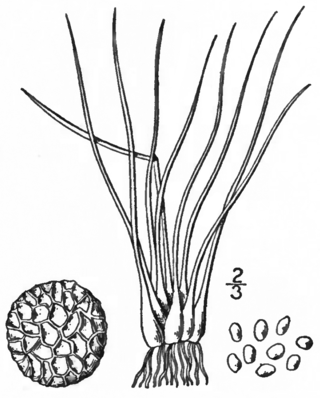
Isoetes tuckermanii, or Tuckerman's quillwort, is a tetraploid species of plant in the family Isoetaceae. It can be found in shallow water in Newfoundland, Nova Scotia, New Brunswick, and south through the New England states to Maryland. It bears 10 to 45 long bright green to yellow green leaves that are 4 to 25 centimeters long, usually erect, but sometimes recurved. The velum covers one fourth or less of the sporangium, which is usually unspotted, 5 millimeters long, and 3 millimeters wide. The white spherical megaspores are 400 to 650 micrometers in diameter, and bear rough-crested ridges that form a hexagonal honeycomb shape. The kidney shaped microspores are 24 to 33 micrometers long, bearing tubercles. It is very similar to I. macrospora, only reliably distinguishable by cytology or through careful megaspore measurement.

Cuscuta australis, commonly known as Australian dodder, is a herb in the family Convolvulaceae.

Isoetes muelleri is a species of quillwort, a type of lycophyte. This generally apomictic aquatic plant is native to Australia.
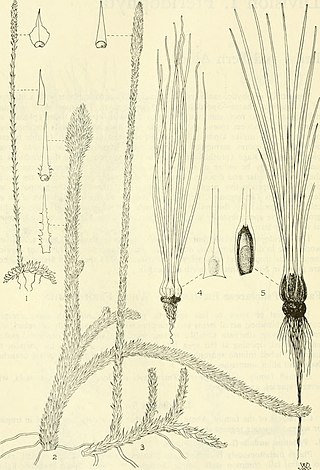
Isoetes melanopoda is a species of nonflowering vascular plant belonging to the quillworts in the family Isoetaceae. Its common names include: black-footed quillwort, midland quillwort, and prairie quillwort.

Solanum esuriale is a species of perennial herbaceous plant native to Australia.
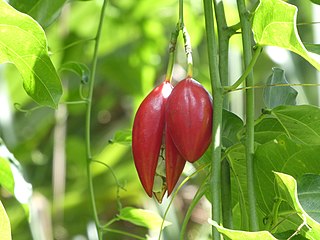
Adenia heterophylla, commonly known in Australia as the lacewing vine, is a climbing plant in the family Passifloraceae. It has a broad distribution spanning the equator, from the south eastern corner of China, through Indochina and Malesia, to northern Australia. In Australia it serves as a food plant for larvae of the glasswing, red lacewing and cruiser butterflies.
Isoetes stephanseniae, the granite quillwort, is a species of quillwort from South Africa, named for A. J. Stephansen, who discovered it in 1927. Of very limited distribution, it is known to survive only as one population in seasonal pools over granite near Stellenbosch, where it is threatened by the encroachment of alien species and eutrophication from the sewage works on whose grounds it grows. Like other quillworts, it bears a tuft of leaves with distinctively sculpted megaspores. It is most similar to Isoetes capensis, the cape quillwort, which occurs in the same province; both hold their leaves at a 45-degree angle, unlike most South African quillworts which have leaves stiffly erect.

















